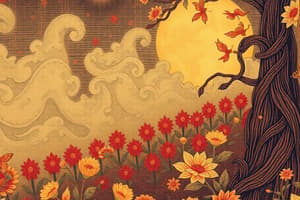Podcast
Questions and Answers
What is the significance of the Man'yōshū in Japanese literature?
What is the significance of the Man'yōshū in Japanese literature?
- It exclusively covers themes of war and politics.
- It is the oldest collection of poetry compiled in 800 A.D. (correct)
- It is a play performed in theaters across Japan.
- It is the first novel in Japanese history.
How many poems are contained in the Man'yōshū?
How many poems are contained in the Man'yōshū?
- More than 2,500 poems.
- Exactly 5,000 poems.
- Over 4,500 poems. (correct)
- Around 1,000 poems.
Which themes are covered in the Man'yōshū?
Which themes are covered in the Man'yōshū?
- Religious texts and philosophy.
- Mythology and historical events.
- Exclusively romantic themes.
- Daily life, nature, love, and grief. (correct)
What is the title of the later compiled collection of poetry mentioned?
What is the title of the later compiled collection of poetry mentioned?
Which of the following forms of Japanese drama is unrelated to poetry collections?
Which of the following forms of Japanese drama is unrelated to poetry collections?
Which of the following statements about the Man'yōshū is true?
Which of the following statements about the Man'yōshū is true?
When was the Man'yōshū compiled?
When was the Man'yōshū compiled?
Which of the following collections was compiled much later than the Man'yōshū?
Which of the following collections was compiled much later than the Man'yōshū?
What distinguishes the Man'yōshū from the other forms mentioned?
What distinguishes the Man'yōshū from the other forms mentioned?
Which of the following themes is NOT covered in the Man'yōshū?
Which of the following themes is NOT covered in the Man'yōshū?
Flashcards
Man'yōshū
Man'yōshū
The oldest anthology of Japanese poetry, compiled in 800 AD. It includes over 4,500 poems covering themes like daily life, nature, love, and grief.
ONE HUNDRED PERSONS
ONE HUNDRED PERSONS
A collection of Japanese poetry, compiled much later than the Man'yōshū.
Noh Play
Noh Play
A traditional Japanese form of musical drama, known for its highly stylized movements, masks, and costumes.
Joruri Play
Joruri Play
Signup and view all the flashcards
Kabuki
Kabuki
Signup and view all the flashcards
What is 'Man'yōshū'?
What is 'Man'yōshū'?
Signup and view all the flashcards
When was 'Man'yōshū' compiled?
When was 'Man'yōshū' compiled?
Signup and view all the flashcards
How many poems are in 'Man'yōshū'?
How many poems are in 'Man'yōshū'?
Signup and view all the flashcards
What are the themes of poems in 'Man'yōshū'?
What are the themes of poems in 'Man'yōshū'?
Signup and view all the flashcards
What is 'ONE HUNDRED PERSONS'?
What is 'ONE HUNDRED PERSONS'?
Signup and view all the flashcards
Study Notes
Japanese Writing System
- The modern Japanese writing system combines Kanji, Hiragana, and Katakana.
- Kanji are ideographs derived from Chinese characters.
- Kana consists of two syllabaries: Hiragana (for native Japanese words) and Katakana (for foreign loanwords and sometimes to replace Kanji or Hiragana for emphasis).
Ancient Literature
- Kojiki (Records of Ancient Matters) describes the creation of the world, the gods and goddesses of the mythological period, and facts about ancient Japan.
- Nihongi (Chronicles of Japan) details Japanese history in poetry, showcasing significant Chinese influence.
Japanese Drama
- Noh play is Japan's national theatre, originally for the nobility. Legend attributes its invention to the gods.
- Joruri play is a puppet play, featuring lifelike, beautifully crafted puppets.
- Kabuki play is for the masses, characterized by a more realistic and sensational style.
Japanese Poetry
- Man'yōshū (Collection of Myriad Leaves) is the oldest Japanese poetry collection, compiled in 800 AD. It contains over 4,500 poems covering various themes, from daily life to nature, love, and grief.
- Tanka is a five-line poem with a syllable structure of 5-7-5-7-7.
- Haiku is a three-line, seventeen-syllable poem with a syllable structure of 5-7-5.
Studying That Suits You
Use AI to generate personalized quizzes and flashcards to suit your learning preferences.
Related Documents
Description
Explore the fascinating aspects of the Japanese writing system, including Kanji, Kana, and Katakana. Delve into ancient literary works like the Kojiki and Nihongi, learn about traditional Japanese drama forms such as Noh, Joruri, and Kabuki, and appreciate classical poetry from the Man'yōshū collection.




